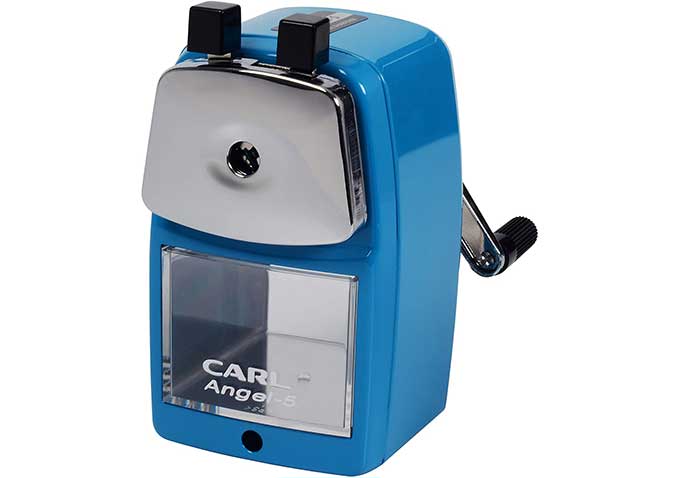Carl Heavy Duty Pencil Sharpener

Automatically draws pencil in
I’m a teacher, so pencils are a big deal for me. I learned of this while researching another pencil sharpener reviewed on Cool Tools. Now that I have it, I couldn’t be happier.
It resembles an old-fashioned wall pencil sharpener from any classroom, but is not wall-mountable. (For me, that’s a feature, because it won’t telegraph the grinding noise through the walls into the room.)
So how can an unmounted classic crank pencil sharpener be used with only two hands? (I don’t have one hand to hold/anchor the unit, another to turn the crank, and a third hand to push the pencil in!)
The answer is in its unique feature: The sharpener, after being extended (you’ve got to see the picture) grabs your pencil, maintains good pressure and self-feeds it into the sharpener. You let go of your pencil, use one hand to hold the base (either in mid-air or anchor it to a shelf) while the other hand turns the crank. When the crank starts turning freely, your pencil is sharp as a tack. (There is an included shelf-mounting clip, and I read about people who rigged up their own mount, but I’m happy to go two-handed.)
These are made by Carl, whose name I recognized from high-end paper cutters. I purchased the basic one, available widely for $20, even though I really want the $45 one, which lets you select from 5 different tip sharpnesses. (I really prefer a blunter tip.) But I wasn’t ready to spend that much on a new technology. Now that I’m familiar with it, I’ll look for an excuse to buy the preferred one, called the “CC-2000”.
When I unscrewed the blade mechanism (which I might have to do to dislodge a broken tip or even eventually replace the blade), I saw what looks like a perfectly standard classroom single blade: a cylinder with spiral cutting edges. Replacement blades are available although, at $20, they cost almost as much as a new machine.
A negative feature, though tolerable for me, is that the clamp mechanism leaves small “bite” marks on the pencil shaft where it clamped its tiny metal spring jaws. They’re not especially noticeable, but if you own high-quality pencils, the thought will make you wince.
I haven’t put this into hard use yet in my classroom, because it’s summer, but the website where I learned of this had rave reviews. It’s available in several satisfying colors, and if you search you can find quantity discounts ($14 for 36-at-a-time, for instance). It’s called different things – “Classroom-friendly pencil sharpener,” “Angel A5 pencil sharpener,” – but I think they’re all the same.
Before buying, make sure you see a video clip of how to use it – extend the spring-controlled holder, squeeze the mini-clamp, insert the pencil all the way and then release the squeeze. Then let go of the pencil and turn the crank. I bet there have been purchasers who didn’t learn to extend the holder – big fail.
I’ve always preferred electric pencil sharpeners, even spending $100 on one once. But this is now my tool of choice.
04/17/20(This is a Cool Tools Favorite from 2013 — editors)
CARL Angel-5 Pencil Sharpener























